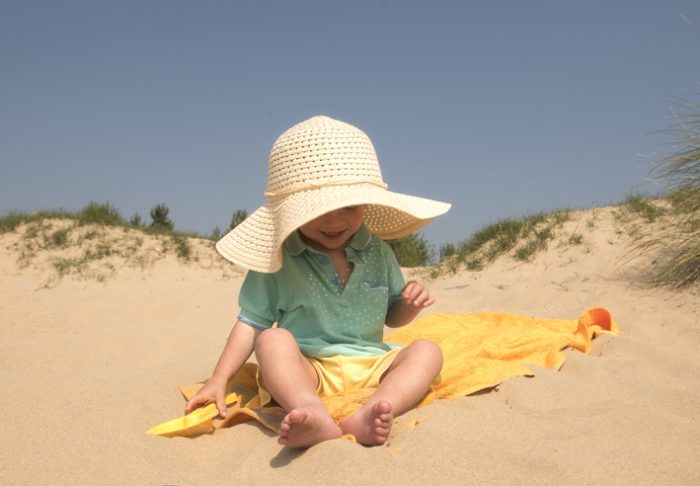Finally, summer is here. The sun is shining. It’s hot. We’re thinking about the lake a lot more than in the first 5.5 months of this year. Yet, as wonderful as this is, babies and children in particular need to be watched carefully during hot weather.
Ça y est, l’été est là. Le soleil brille. Il fait chaud. Nous pensons beaucoup plus au lac que pendant les cinq premiers mois et demi de l’année. Mais aussi agréable que cela puisse être, il est essentiel de surveiller tout particulièrement les bébés et les jeunes enfants par temps chaud. (résumé en français ci-dessous)
Babies and children sweat less, reducing their ability to cool down, and they generate more heat during exercise than adults.
They are at higher risk of overheating and developing a heat-related illness. Heat can also make existing illnesses worse.
Tips to help keep babies and children safe in the heat
- understand that babies and children overheat and dehydrate quickly
- breastfeed or bottle-feed your baby more often
- offer older babies and children extra drinks in hot weather – the best drink is water
- dress babies and children in cool clothing and protect them from the sun with hats and sunscreen
- never leave children in the car
- if your child is sick (fever, vomiting, diarrhoea, or even a mild cold), they need extra attention to ensure they remain well hydrated and don’t overheat. See your GP if your child is unwell.
Drink enough fluids
During hot weather, it’s important your child has enough fluids.
To ensure your child is having enough fluids:
- offer drinks or breastfeeds frequently, as babies and young children are not able to tell you that they are thirsty
- breastfeed or bottle-feed babies less than six months old more often (water or other drinks are not needed unless recommended by a GP)
- offer small amounts of cooled boiled water to babies over six months old, after or between milk feeds
- use a towel, sheet or nappy between yourself and your baby during feed times to avoid skin contact
- check your baby is getting enough fluids, a good sign is if they’ve had six to eight pale wet nappies in the last 24-hours
- drink plenty of water if you’re breastfeeding
- offer young children water as their main drink throughout the day (fruit juice, fruit-based drinks and fizzy drinks are not recommended)
- encourage older children to drink regularly, especially if they forget to drink because they are busy playing.
Keep cool
An important way to keep your child healthy in the heat is making sure they are cool.
Dress them in cool clothing
To help keep children cool, dress them in light, loose clothing.
You can also protect them from the sun with a broad-brimmed hat and sunscreen.
Keep their environment cool
Keeping the environment your child is in cool helps protect them from the heat.
To keep them cool:
- choose the coolest room in the house for sleeping. Keep the heat out by closing the curtains and making sure air can circulate around the bassinette or cot (don’t use liners or padding). Don’t leave babies asleep in a pram as they can become very hot.
- cool your child with damp cloths and place wet towels or sheets around the bassinette or cot to cool the air immediately near them. Check regularly to make sure they are not getting too cold.
- give your child a lukewarm bath or sponge them down with lukewarm water. Don’t use cold water or ice in the bath.
- use fans to keep the air circulating. Don’t point fans directly at your child and make sure they can’t touch the fan.
- make sure the room does not get too cold when using an air-conditioner, 24-26 degrees Celsius is low enough.
- spend time in cool places like a library, shopping centre, cinema or other public buildings if your house does not have air-conditioning or can’t be cooled down.
Stay inside
Try to keep your children inside, particularly during the hottest parts of the day (between 11am and 5pm). Plan your activities for early morning, late afternoon or evening.
If you must go out, protect your child’s skin from the sun by keeping them in the shade or covering with loose clothing and a broad-brimmed hat. You can also use small amounts of sunscreen with a minimum SPF 30+ on skin which cannot be covered.
If your child does a lot of outdoor activities and exercise, take regular breaks and provide plenty of fluids.
Don’t leave babies or children in cars
Never leave babies, children or pets alone in a car, not even for a moment. Babies and children can overheat very quickly in cars.
The temperature inside a parked car can be 30-40 degrees Celsius hotter than outside the car. Most of the temperature increase occurs within five minutes of closing the car and having the windows down 5 cm causes only a very slight decrease in temperature.
Never cover a baby capsule in the car with a blanket, towel or baby wrap as this will restrict air moving around the baby, making them hotter. Use sunshades on windows instead.
When planning a longer car journey, try to travel in the cooler hours of the day, dress your child lightly and provide plenty of cool water during the journey.
Avoid enclosed prams and strollers
An enclosed pram can get very hot. Try to ensure that the air circulates around your baby by removing the back panel or placing them in a more open stroller.
Only cover your baby’s pram or stroller with a light cloth that still allows the air to circulate.
If your child seems unwell during hot weather, please seek medical advice immediately.
Source: Admittedly, this source is kind of « far-fetched » in the literal sense of the word. But who, if not the Australians, knows how to deal with heat? So, this time we rely on the advice of the New South-Wales’ Government Health Department.
Les bébés et les jeunes enfants transpirent moins, ce qui réduit leur capacité à se rafraîchir, et ils produisent plus de chaleur que les adultes lorsqu’ils bougent.
Ils courent donc un risque plus élevé de surchauffe et de développer des problèmes de santé liés à la chaleur. La chaleur peut aussi aggraver des maladies existantes.
Conseils pour garder les bébés et les enfants en sécurité par temps chaud
-
Gardez en tête que les bébés et les enfants se déshydratent et surchauffent rapidement.
-
Allaitez ou donnez le biberon plus souvent.
-
Proposez aux bébés plus âgés et aux enfants de l’eau plus fréquemment – la meilleure boisson, c’est l’eau.
-
Habillez-les avec des vêtements légers et protégez-les du soleil avec un chapeau et de la crème solaire.
-
Ne laissez jamais un enfant seul dans une voiture.
-
Si votre enfant est malade (fièvre, vomissements, diarrhée ou même un simple rhume), il faut le surveiller de près pour qu’il reste bien hydraté et ne surchauffe pas. Consultez un médecin si besoin.
Bien s’hydrater
Quand il fait chaud, il est essentiel que votre enfant boive suffisamment.
Pour vous assurer qu’il est bien hydraté :
-
Proposez régulièrement à boire ou à téter, car les petits enfants ne disent pas toujours qu’ils ont soif.
-
Allaitez ou donnez le biberon plus souvent aux bébés de moins de 6 mois (l’eau ou d’autres boissons ne sont pas nécessaires sauf avis médical).
-
Pour les bébés de plus de 6 mois, proposez de petites quantités d’eau bouillie et refroidie après ou entre les tétées.
-
Utilisez une serviette, un drap ou une couche entre vous et votre bébé pendant les tétées pour éviter un contact peau à peau trop chaud.
-
Vérifiez que votre bébé est bien hydraté – un bon indicateur est s’il a eu 6 à 8 couches bien mouillées et claires en 24 heures.
-
Buvez suffisamment d’eau si vous allaitez.
-
Proposez de l’eau comme boisson principale aux jeunes enfants tout au long de la journée (les jus de fruits, boissons sucrées ou gazeuses ne sont pas recommandés).
-
Encouragez les enfants plus âgés à boire régulièrement, surtout s’ils oublient parce qu’ils sont en train de jouer.
Rester au frais
Un bon moyen de protéger votre enfant de la chaleur, c’est de s’assurer qu’il reste au frais.
Des vêtements adaptés
Habillez votre enfant avec des vêtements légers et amples. Protégez-le du soleil avec un chapeau à larges bords et de la crème solaire.
Un environnement frais
Gardez son environnement aussi frais que possible :
-
Choisissez la pièce la plus fraîche de la maison pour les siestes. Gardez la chaleur dehors en fermant les rideaux, et assurez-vous que l’air circule bien autour du lit (évitez les tours de lit ou rembourrages). Ne laissez pas les bébés dormir dans une poussette fermée, cela peut vite devenir trop chaud.
-
Rafraîchissez votre enfant avec des linges humides et placez des serviettes ou draps mouillés autour du lit pour rafraîchir l’air à proximité. Vérifiez régulièrement qu’il n’a pas trop froid.
-
Donnez-lui un bain tiède ou épongez-le avec de l’eau tiède (pas froide ni glacée).
-
Utilisez un ventilateur pour faire circuler l’air, mais ne le dirigez pas directement sur l’enfant et assurez-vous qu’il ne peut pas le toucher.
-
Si vous utilisez la climatisation, veillez à ne pas descendre en dessous de 24 à 26°C.
-
Si vous ne pouvez pas rafraîchir votre logement, passez du temps dans des lieux climatisés comme une bibliothèque, un centre commercial, un cinéma ou un autre bâtiment public.
Restez à l’intérieur
Essayez de garder vos enfants à l’intérieur pendant les heures les plus chaudes de la journée (entre 11h et 17h). Préférez les sorties tôt le matin, en fin d’après-midi ou le soir.
Si vous devez sortir, protégez leur peau du soleil en restant à l’ombre ou en les habillant avec des vêtements légers et un chapeau. Vous pouvez aussi utiliser une petite quantité de crème solaire avec un indice de protection minimum de 30 sur les zones exposées.
Si votre enfant fait du sport ou joue longtemps dehors, faites des pauses régulières et proposez souvent à boire.
Ne jamais laisser un enfant dans une voiture
Ne laissez jamais un bébé, un enfant ou un animal seul dans une voiture – même pour quelques minutes. La température à l’intérieur peut grimper très vite.
Une voiture garée peut être de 30 à 40°C plus chaude que l’extérieur. Et ouvrir légèrement la fenêtre (5 cm) ne suffit pas à réduire la température de manière significative.
Ne couvrez jamais un siège-auto avec une couverture, une serviette ou un lange – cela bloque la circulation de l’air et rend l’enfant encore plus chaud. Utilisez plutôt un pare-soleil sur la vitre.
Si vous partez pour un long trajet en voiture, voyagez aux heures les plus fraîches, habillez votre enfant légèrement et proposez-lui régulièrement de l’eau fraîche.
Évitez les poussettes fermées
Une poussette fermée peut vite devenir très chaude. Essayez de faire circuler l’air autour de votre bébé en ouvrant l’arrière ou en optant pour une poussette plus aérée.
Ne couvrez la poussette que d’un linge léger qui laisse passer l’air.
Si votre enfant semble mal en point par temps chaud, consultez un professionnel de santé sans attendre.
Source: Admittedly, this source is kind of « far-fetched » in the literal sense of the word. But who, if not the Australians, knows how to deal with heat? So, this time we rely on the advice of the New South-Wales’ Government Health Department.

